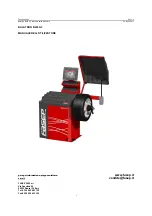
20 •
Important: Always read and follow the operating instructions.
Separator/Lubricator Maintenance
Check oil and water levels regularly, and perform
these maintenance items weekly:
A.
Disconnect air supply to machine.
B.
The Separator (Filter) unit is equipped with an auto-
matic drain and should not normally need draining.
C.
If the fluid level is greater than 1/4" from the top of
the gauge, add oil. Remove the filler plug on top of the
lubricator and add SAE 10W non-detergent oil or an air
tool oil to bring the level up to 1/4" from the top of the
gauge. Replace filler plug and clean up any spilled oil.
D.
Adjust the oil flow by turning the black flow adjust-
ment knob and turning it to increase or decrease the
flow. Watch the formation of oil drops in the see-
through oil chamber. Reconnect the air supply and con-
tinually cycle the bead loosener through full strokes
and count the drips during the cycles. The delivery of
oil to the airline should be about 1 drop per 10 cylinder
cycles. Adjust flow as required.
Duckhead
®
Cleaning
Clean dirt and debris from the duckhead roller with a
small screwdriver or pick.
Pressure Limiter Maintenance
Operating a tire changer with a defective,
improperly adjusted, or by-passed pressure
limiter could cause an operator to acciden-
tally over pressurize a tire, resulting in a tire
explosion with severe injury or death to the
operator or bystanders.
Always be sure that the pressure limiter is
present and is operating properly.
Never inflate tire above manufacturer’s rec-
ommended pressure after bead is seated.
Pressure limiter is set at 60 PSI. Any
required inflation above 60 PSI should be
performed in an inflation chamber/safety
cage or securely mounted on the vehicle if
an inflation chamber is not available. A tire
explosion may cause personal injury or
death to operator or bystanders.
The pressure limiter helps prevent inflation of stan-
dard size or larger tires or tubes beyond 60 PSI to min-
imize risk of explosion. This device is for the safety of
the operator and bystanders. Proper operation of the
pressure limiter is essential to safe operation of the
machine.
Check operation of the pressure limiter as shown and
described below at least monthly:
1.
Remove tires and/or wheels from the machine.
2.
Connect the inflation hose to an empty service
tank with a pressure gauge (gauge should read 0). Use
a certified tank with at least 250 PSI pressure rating.
DANGER
DANGER
Auto
Drain
Outlet
Air In
Air Out
Oil Fill
Oil Flow
Adjust
Lubricator
Separator
250 PSI Tank
with Gauge
Watch Pressure
on Both Gauges
Tire Changer
Inflation Hose
Connected to Tank




























